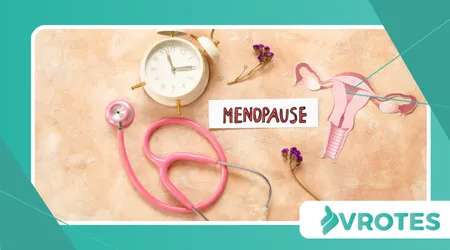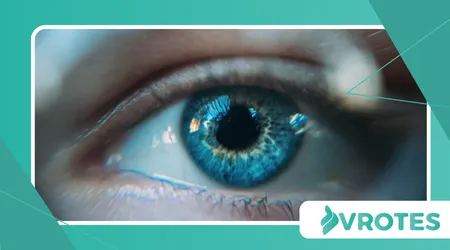Menopause and Vision Changes: What to Expect

Menopause and Vision Changes. The eye, an organ rich in receptors for sex steroids, is exquisitely sensitive to hormonal fluctuations.
Anúncios
Estrogen, progesterone, and androgens all play significant roles in maintaining the health and functionality of the ocular surface and deeper structures.
These hormones are integral for tear production, corneal shape, and even retinal integrity.
The drop in estrogen, which defines the menopausal transition, acts like pulling the main energy plug on various eye tissues.
This decline can lead to structural and functional changes across the visual system. We must acknowledge that these shifts are not mere coincidences occurring at the same time as aging.
Anúncios
Why is Dry Eye Disease So Common During Menopause?
This specific condition is perhaps the most widespread visual complaint among midlife women, moving beyond a simple nuisance to a chronic health issue.
Estrogen and androgens significantly regulate the function of the lacrimal glands and the meibomian glands, essential for tear quality and quantity.
When these hormones diminish, the natural balance of the tear film is compromised.
The tear film, a complex three-layer structure, destabilizes without adequate oil production from the meibomian glands.
This leads to tears evaporating too quickly, even if the eyes water excessively in a reflex response to the underlying dryness.
A gritty sensation, persistent burning, and redness become daily realities for many.
Read here: How Menopause Impacts Your Circadian Rhythm
Consider this: Dry Eye Disease is significantly prevalent.
According to a recent cross-sectional analytical observation study involving over 3,500 women, the prevalence of dry eye disease was reported at 57.38% in postmenopausal women, highlighting the clinical significance of hormonal status on ocular comfort.
Can Menopause Cause Blurred or Fluctuating Vision?
Absolutely, and often in unexpected ways that can cause real concern. The decrease in estrogen can subtly impact the cornea, the clear front surface of the eye.
Estrogen helps maintain the cornea’s thickness and flexibility, so its reduction can lead to minor changes in the corneal curvature.
This slight reshaping alters the way light refracts onto the retina, which can manifest as fluctuating or mild blurring of vision.
For women who wear contact lenses, this corneal change can suddenly make their usual lenses incredibly uncomfortable to wear.
It’s like trying to fit an old key into a slightly warped lock—it just doesn’t feel right anymore.

What Are Other Less-Known Connections Between Menopause and Vision Changes?
Beyond the surface-level issues, hormonal shifts during menopause are increasingly linked to conditions affecting the deeper structures of the eye.
Check this out: The Surprising Link Between Menopause and Gum Health
This emphasizes why comprehensive eye exams are non-negotiable during this decade.
Is There a Link to Glaucoma?
Emerging research suggests a potential association between earlier menopause and an increased risk of developing open-angle glaucoma, a condition characterized by pressure on the optic nerve.
Estrogen is thought to have a protective effect on the delicate tissues of the optic nerve.
Losing this hormonal shield might render the eye more vulnerable to pressure-related damage over time.
For example, a woman who entered menopause at age 42, years earlier than the average, might be at a statistically higher baseline risk for glaucoma compared to her peers.
This highlights the need for clinicians to screen with greater vigilance.
Are Cataracts and Macular Degeneration Related to Menopause?
While the core mechanisms of cataracts (clouding of the lens) and age-related macular degeneration (AMD) are largely related to oxidative stress and aging, menopausal status appears to be a factor.
Women are simply more susceptible to developing cataracts and tend to develop them earlier than men.
See how interesting: How to Adjust HIIT for Fluctuating Energy Levels
Furthermore, reduced estrogen levels may influence retinal health, possibly increasing vulnerability to AMD.
These conditions do not appear overnight but are instead a slow erosion of function, much like rust forming on a vital component. Early, proactive management is key.
Here is an overview of common vision issues exacerbated by the menopausal transition:
| Ocular Condition | Primary Menopausal Mechanism | Key Symptoms |
| Dry Eye Disease | Decreased Estrogen/Androgen affecting tear glands | Grittiness, burning, fluctuating vision, redness |
| Corneal Changes | Loss of Estrogen affecting corneal elasticity | Blurred vision, contact lens intolerance |
| Glaucoma Risk | Loss of Estrogen’s protective effect on the optic nerve | Loss of peripheral vision (often asymptomatic early) |
| Cataracts | Increased prevalence in post-menopausal women | Cloudy vision, glare sensitivity |

How to Proactively Manage Menopause and Vision Changes
The good news is that women are not passive participants in these changes; there are intelligent, proactive steps to take.
Simple adjustments often yield significant relief, starting with proper lubrication for dry eyes.
High-quality artificial tears are excellent, but focusing on Omega-3 fatty acids, managing screen time with the 20-20-20 rule, and ensuring adequate hydration are also vital.
Furthermore, an experienced optometrist or ophthalmologist specializing in menopausal eye health should be part of every woman’s health team.
They can assess your tear film stability and look for early, subtle signs of conditions like glaucoma, often before any symptoms appear.
Should hormone therapy be an option for managing other symptoms, your eye doctor can monitor its overall effects on your vision.
Isn’t it time we stopped dismissing these persistent eye issues as merely “getting older” and recognized the profound impact of hormonal changes?
Menopause and Vision Changes
The link between Menopause and Vision Changes is undeniable and extends well beyond surface irritation.
From the epidemic of dry eye disease to potential increases in the risk for more serious conditions like glaucoma, the eyes reflect the body’s major hormonal shift.
Proactive screening, lifestyle adjustments, and candid conversations with healthcare providers are the definitive pathways to maintaining vibrant, clear vision well into the later stages of life.
Frequently Asked Questions
Can Hormone Replacement Therapy (HRT) Help Menopause-Related Dry Eyes?
HRT’s effect on dry eyes is complex and varies by individual. Some women find relief as estrogen levels are stabilized, potentially improving tear quality.
Others may experience no change or, in rare cases, a worsening of symptoms. You should discuss this thoroughly with your prescribing physician and ophthalmologist.
Do My Contact Lenses Need to Change During Menopause?
Yes, frequently. Due to the subtle changes in corneal shape and the quality of the tear film, the comfort and fit of your existing contact lenses can drastically change.
An eye doctor may recommend switching to a different lens material or a more rigorous dry eye treatment plan.
When Should I See an Eye Specialist Immediately?
Any sudden or severe change in vision, such as a loss of peripheral vision, a dark curtain over your sight, sudden double vision, or intense eye pain, requires immediate evaluation by an ophthalmologist.
Are there specific nutrients that support eye health during menopause?
Yes. Beyond Omega-3 fatty acids (found in fish oil or flaxseed), nutrients like Lutein, Zeaxanthin, and Vitamins C and E are known to support retinal health and can be found in dark, leafy greens and colorful vegetables.
